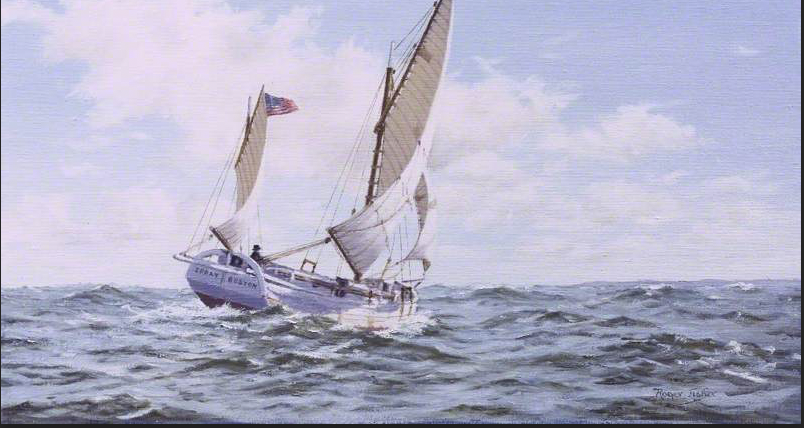On June 27th, 1898 Joshua Slocum became the first person to sail around the world by himself in his vessel, the Spray.
If he had not accomplished this he would still be notable, as he was truly a sailor’s sailor. One of 11 children, he was born in Nova Scotia in 1844 but soon became bored making shoes in the village for his father. So at his first opportunity, he shipped out as cabin boy to Liverpoop (just south of Liverpool) At 14 he jumped at the opportunity to ship out as a cabin boy and from then on spent most of his life at sea or in ports of call.
He met and married his match in Virginia Walker. She bore seven children and all were delivered on board or in foreign ports. She was Australian and he was Canadian. Slocum’s ancestors had fled the US as Loyalists to King George during the Revolutionary War but Slocum, Virginia and their children were Americans through and through.
Over many years the family helmed ships owned by others but eventually Joshua built his own boats and ships. He was a very successful captain with his longest home port being San Francisco. His exploits are so numerous that a perusal of his Wiki page is pretty rewarding https://en.wikipedia.org/wiki/Joshua_Slocum

He skippered all manner of craft. One in particular was an ironclad warship with the first underwater torpedo system. It leaked so badly that even with manning the pumps day and night they barely survived and once it arrived in Brazil it failed to fire.
Joshua was a general cargo hauler, a fur merchant, a spice shipper and a fisherman. Ships sunk under him in hurricanes and were seized in mutinies. Yet he was known as a kind man and was highly sought after to run vessels.
And with all that, the big story is even more astounding. Joshua was 50 when he found an old, derelict sailing scow and decided to rebuild it.

After outfitting her he set sail around the world by himself in April 1895. He left from Boston, for Nova Scotia to say goodbye to family and then headed for the Suez Canal. But as he arrived at Gibraltar he was persuaded that the Mediterranean pirates would skin him and used his bones to pick their teeth so he turned left and headed south. Cape Horn, at the bottom of South America, is known as the least forgiving stretch of seawater on earth and in a 39-foot vessel with a shallow keel it took him 40 days to make the passage.
He finally entered the Pacific and as he was coasted along the shore some unfriendly natives decided they would like to have his stuff and him too so Joshua had to continually fire his rifle in their direction throughout the day. At night he scattered metal tacks on deck to impale those who dared board in the dark.
All throughout his voyage he was interviewed and lectured. Like so many before him floated on his press clippings as the news of his circumnavigation preceded him. His vessel and the way it was rigged was extraordinary in that he could set a course in most weather, lash the tiller and basically have the boat self-steer. He reported one run in the Indian Ocean of 2,000 miles without touching the tiller once. Between 800 and 1,000 full size reproductions of his remarkable vessel have been built.

In South Africa at the end of year two he ran into a unique problem. By then he was well known and some supporters had rented a large hall so he could give a lecture. But the government got wind of the fact that he was going to tell folks of his adventures sailing all the way round. The problem was that the conservative Boers held, as official doctrine, that the world was flat. He actually debated this issue in public with the president of the country. This just 110 years ago. Today, we would think of this as part of a Big Lie but we live in a modern age where no one in government lies. Oh, thank goodness.
When Joshua returned from his 46,000 mile trip but he received little notice as war with Spain had just broken out and was sucking up all the headlines. However, in 1899 he published his masterwork Sailing Alone Around the World and the world took notice. He became quite famous and continued to write and lecture.
He lived in New England but every summer sailed to the Caribbean in the Spray. It was on one of these trips Joshua and the tiny ship were lost at sea and never heard from again.
If you read one book about the sea, read Moby-Dick. But if you read two, read this one.





More than a few years ago while hanging around Pete’s harbor In Redwood city I met a couple that were tied up at his dock. They were older of course I was in my twenties so everyone was old but they had sailed down from SF in a 3/4 version of Spray. Don’t know what happened to her but it was a pretty boat.